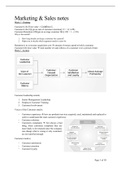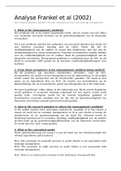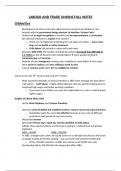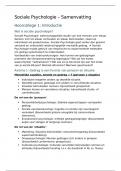Marketing & Sales notes
Week 1 – Training
Customer Life-Time value = Cashflows/¿
Customer Life (N)[ given rate of customer retention]; N = 1/(1-CR)
Customer Retention (CR)[given average customer life]; CR = 1 – (1/N)
Why is this useful?:
1. How long should you keep a customer for a period?
2. Helps you to decide which segments needs to cater for
Retention is to overcome acquisition cost amount of money spend to hold a customer
Customer life time value total number of cash inflows of a customer over a period of time
Week 1 – Lecture
Customer leadership entails;
1. Senior Management Leadership
2. Employee Customer Training
3. Customer Involvement
Voices of the Customer entails;
- Customer experience how are products/services acquired, used, maintained and replaced in
order to understand the total customer experience.
- Customer solutions
- Customers complaints Not always a bad
thing, when customers complains they are
more likely to be retained since the company
can change what is wrong or why customers
are not satisfied enough.
Customer metrics;
- Customer satisfaction
- Customer retention
- Customer loyalty
Page 1 of 10
, Week 3 – Training
Price Elasticity of Demand
Price elasticity of demand is used to determine how a change in price affects consumer demand. If
consumers still purchase a product despite a higher price increase (such as cigarettes and fuel) that
product is considered inelastic. On the other hand, elastic products suffer from pricing fluctuations
(such as cable TV and movie tickets). To calculate price elasticity you use the following formula:
% Change in quantity and or volume / % Change in price = price elasticity of demand
Between 0 and -1= inelastic
Greater dan -1 = elastic
When a product is elastic, a change in price quickly results in a change in the quantity demanded.
When a good is inelastic, there is little change in the quantity of demand even with the change of the
good’s price. When the percentage change in volume is greater than the percent change in price, we
have an elastic price. When the percentage change in volume is less than the percent change in price,
we have in inelastic price.
Inelastic price never lower the price when a price is inelastic. A lower price will result in lower
sales and lower profits.
Elastic price use caution when lowering prices when price are elastic. If percent margins are low,
a lower price will increase sales but often result in profits.
Types of pricing
1. Competitive pricing
Competition-based pricing is also known as competitive pricing or competitor-based pricing.
This pricing strategy focuses on the existing market rate (or going rate) for a company’s
product or service. It doesn’t take into account the cost of their product or consumer demand.
Instead, a competition-based pricing strategy uses the competitors’ prices as a benchmark.
Businesses who compete in a highly saturated space may choose this strategy since a slight
price difference may be the deciding factor for customers. With competitive pricing, you can
price products slightly below, the same as, or slightly above the competition. For example, if
you sold software, and your competitors’ prices ranged from $19.99 per month to $39.99 per
month, you’d choose a price between those two numbers. Competitive pricing is a way to stay
on top of the competition and keep pricing dynamic.
In marketing practice;
Consumers primarily seek the best value, which isn’t always the same as the lowest price.
Pricing products and services competitively in the market can put your brand in a better
position to win business. Competitive pricing works especially well when a business offers
Page 2 of 10
Week 1 – Training
Customer Life-Time value = Cashflows/¿
Customer Life (N)[ given rate of customer retention]; N = 1/(1-CR)
Customer Retention (CR)[given average customer life]; CR = 1 – (1/N)
Why is this useful?:
1. How long should you keep a customer for a period?
2. Helps you to decide which segments needs to cater for
Retention is to overcome acquisition cost amount of money spend to hold a customer
Customer life time value total number of cash inflows of a customer over a period of time
Week 1 – Lecture
Customer leadership entails;
1. Senior Management Leadership
2. Employee Customer Training
3. Customer Involvement
Voices of the Customer entails;
- Customer experience how are products/services acquired, used, maintained and replaced in
order to understand the total customer experience.
- Customer solutions
- Customers complaints Not always a bad
thing, when customers complains they are
more likely to be retained since the company
can change what is wrong or why customers
are not satisfied enough.
Customer metrics;
- Customer satisfaction
- Customer retention
- Customer loyalty
Page 1 of 10
, Week 3 – Training
Price Elasticity of Demand
Price elasticity of demand is used to determine how a change in price affects consumer demand. If
consumers still purchase a product despite a higher price increase (such as cigarettes and fuel) that
product is considered inelastic. On the other hand, elastic products suffer from pricing fluctuations
(such as cable TV and movie tickets). To calculate price elasticity you use the following formula:
% Change in quantity and or volume / % Change in price = price elasticity of demand
Between 0 and -1= inelastic
Greater dan -1 = elastic
When a product is elastic, a change in price quickly results in a change in the quantity demanded.
When a good is inelastic, there is little change in the quantity of demand even with the change of the
good’s price. When the percentage change in volume is greater than the percent change in price, we
have an elastic price. When the percentage change in volume is less than the percent change in price,
we have in inelastic price.
Inelastic price never lower the price when a price is inelastic. A lower price will result in lower
sales and lower profits.
Elastic price use caution when lowering prices when price are elastic. If percent margins are low,
a lower price will increase sales but often result in profits.
Types of pricing
1. Competitive pricing
Competition-based pricing is also known as competitive pricing or competitor-based pricing.
This pricing strategy focuses on the existing market rate (or going rate) for a company’s
product or service. It doesn’t take into account the cost of their product or consumer demand.
Instead, a competition-based pricing strategy uses the competitors’ prices as a benchmark.
Businesses who compete in a highly saturated space may choose this strategy since a slight
price difference may be the deciding factor for customers. With competitive pricing, you can
price products slightly below, the same as, or slightly above the competition. For example, if
you sold software, and your competitors’ prices ranged from $19.99 per month to $39.99 per
month, you’d choose a price between those two numbers. Competitive pricing is a way to stay
on top of the competition and keep pricing dynamic.
In marketing practice;
Consumers primarily seek the best value, which isn’t always the same as the lowest price.
Pricing products and services competitively in the market can put your brand in a better
position to win business. Competitive pricing works especially well when a business offers
Page 2 of 10











